Ryburgh Bakery
It is not unusual for a press clipping to spark off a line of enquiry into Ryburgh History and the following is just such a one that made me think about what it must have been like in Ryburgh before the Smith family industrialised malting in the area. It was printed in the Norfolk Chronicle in March 1829 and illustrates a local tradition of malting 30 years before F. & G. Smith ever set foot in Ryburgh
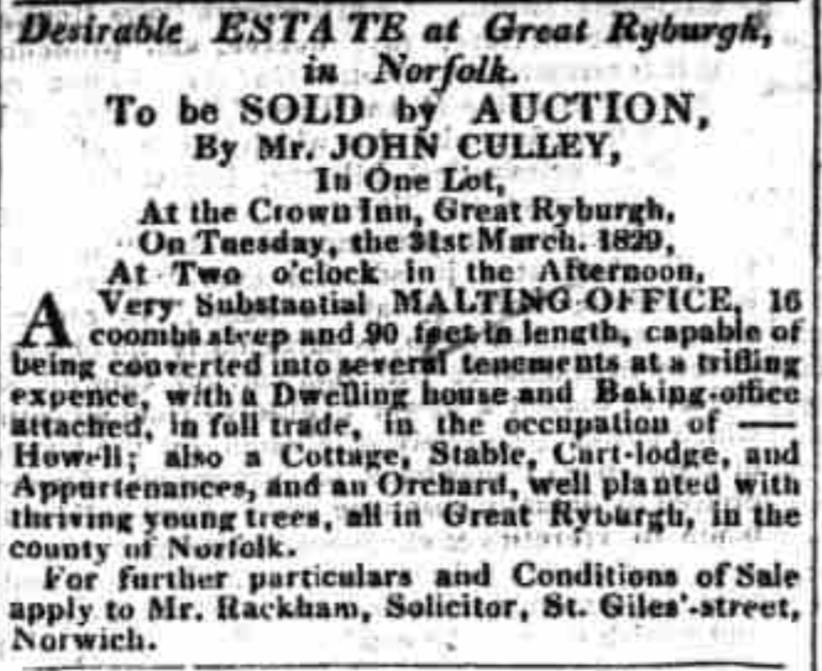
For those with a technical bent, please correct me if I am wrong but I believe a 16 coomb steep would have dealt with one Ton and twelve Cwts. of grain. It is not entirely clear if the Malting Office was “in full trade” in view of the advertised option to cheaply convert to dwellings. The Baking Office certainly was a going concern, a fact substantiated by the presence of Henry Howell, “Baker” in the Church Registers, from the 1841 Ryburgh Census and for the following 30 years “Baker and Miller”
It is indeed fortunate that the current owner of the old bakehouse was presented by a solicitor with a bundle of old deeds relating to the property which allow us to trace some of its history from 11th. May 1763. It is further more than fortunate that I have been given access to them for which I am very grateful and without which this page would not have been very informative.
First and foremost it confirmed that the plot, No 324 on the 1810 Inclosure Map in the possesion of J[ohn] Gardiner was the site of the present bakehouse. However the description of the plot did not specify either a bake or a malting office just that it was 37 perches ( just under an acre ,which is 40 perches) with “a messuage and other buildings, copyhold of the Manor of Great Ryburgh”.
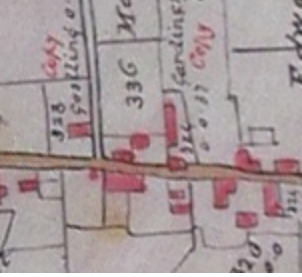
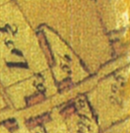
It is useful to note that at this time the buildings on the plot all align with the Western boundary and not as they do today on the Eastern. This is corroborated by the post 1823 map (now showing as plot 56) which must date from around the time of the sale particulars notice
A look at the earliest of the documents which is dated Friday 6th July 1770 gave more information:
This is a copy of the Manor Roll entry recording the surrender of the plot by John Baly back to Mary Bacon, Spinster, Lady of the Manor and the beginning of the tenancy of “James Hewitt of Great Ryburgh in Norfolk Gentleman”, just a month before the baptism of his twin daughters Elizabeth and Maria. Unfortunately the church registers at this time gave no further information at all about James and Elizabeth Hewitt.
This parchment is very creased and difficult to read but it does specificaly refer to a Malthouse on the plot. This, we must assume be the long (90feet) separate building as shown on the maps to the rear of the plot.
The malting process would have been carried out on a small scale in such premises all over Norfolk. The arrival in Ryburgh of Frederick and George Smith in the late 1850’s, initially as farmers, millers and grain merchants changed all that forever. The Railway has to have been an important factor in the decision to set up business in Ryburgh but without being able to pinpoint the date of the purchase of the copyhold leases of the land adjacent to the railway in Ryburgh, it is difficult to give an accurate start date to the largescale manufacture of malt in Ryburgh.
A larger scale Maltings was already under construction in Fakenham opposite the Eastern Station in 1866 as witnessed by this account in the press dated November 3rd 1866:
ACCIDENT.- On Tuesday morning last, about nine o'clock, a heavy gale of wind blew down the roof of the large malt kiln in course of erection opposite the railway station. A few minutes before the fall of the roof, a number of men were at work upon it, but fearing they might be blown off, they all descended just in time to prevent the accident being attended with fatal results, and fortunately none of the men were injured; but the damage done is considerable, and the loss sustained by Mr. Turner , the builder, is, we regret to say, very heavy.
Is this the sort of large scale new build that fired the brothers’ enthusiasm for an extension of their already expanding empire?
Betty Wharton’s book “The Smiths of Ryburgh” gives no reliable suggestions as to the exact start of the Ryburgh maltings, but she does give dates of 1870 and 1872 for the purchases of the Dereham land alongside the railway. It is once again that we have to turn to the newspapers for other clues and where we find Frederick Smith still described as a Miller and Corn Dealer in the report of the prosecution of William Empson for theft in January 1872.
By 1876 however something is certainly happening at Ryburgh when we read of the following accident:
Norwich Mercury 4 November 1876
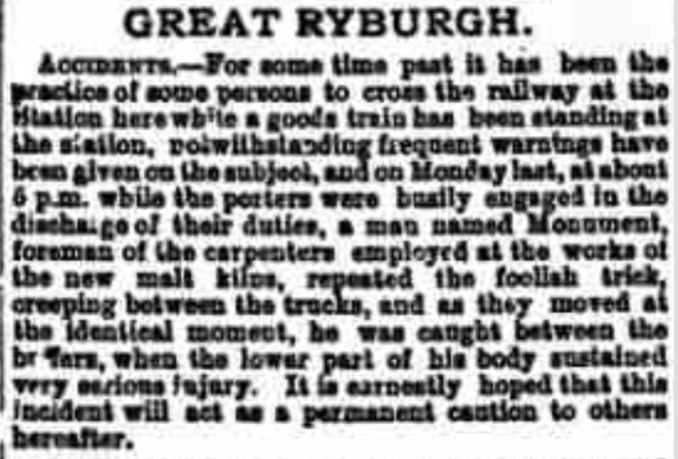
1877 finally provides concrete evidence of a business that was up and running and furthermore, leads one to infer that larger scale Malt production could well have been first carried out by the Smiths in Wells before starting in either Dereham or Ryburgh:
Norfolk Chronicle 2 June 1877:
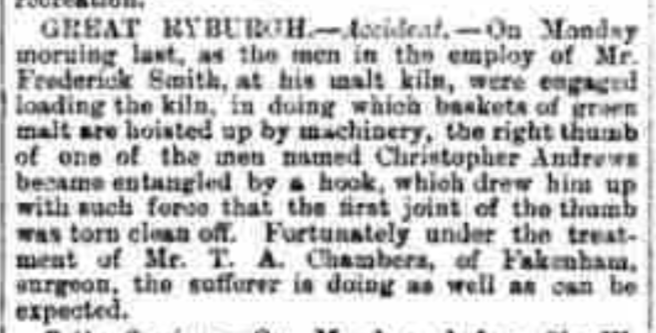
Lynn Advertiser 30 June 1877:
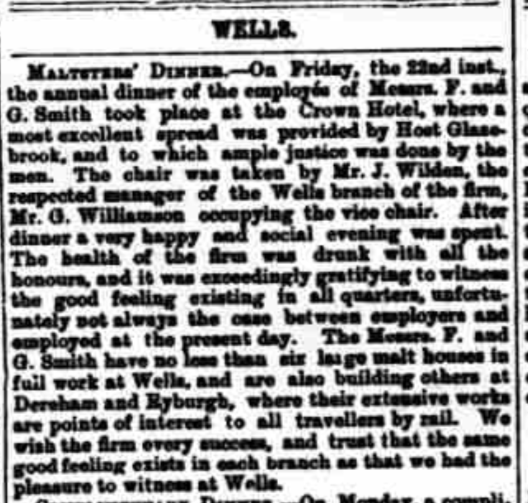
A year later on June 22 1878 in the pages of the Lowestoft Journal we read:
TREAT TO WORKMEN.- On Friday evening last the workmen, who have just completed the malting for the season, on the premises of Mr Frederick Smith, merchant and farmer were regaled by that gentleman at the Boar Inn by a substantial dinner provided by Host Neal. Song and other sources of amusement followed, and the thanks of the party given to Mr. Smith for his generosity.
Returning to the bakehouse site, it is easy to presume that “Baking-office” refers to the present house alongside the Village Hall in Fakenham Road as it is within living memory that it was the village bakery. Examining the deeds shows that the lease continued changing hands with names that are associated with both millers and bakers as tenants and millers and gentlemen as the copyholders. Henry Howell continued baking into the early 1870’s and just at the 1861 Census, two separate bake offices are described in the village, with the other run by Mark Jarvis, “Miller and Baker”.
If the existence of the malthouse on the bakehouse site was ever any inspiration for the Smith’s ambitions we shall never know. What is obvious however, the fact that such a small operation would have been in no way able to compete with what was to be the giant complex next door being constructed in the mid 1870’s.
In the 1871 Census we have a new baker’s name in addition to that of Henry Howell, one James Waters. It is he who is described in documents concerning some financial difficulties as “having newly built a bake-office on the site” around 1880. This was exactly the time when Thomas Cooper was lodging with his family upon taking up management of the Foundry. Together with the Maltings, Ryburgh must have had the air of a really progressive and modern Victorian community.
These new premises continued to be the succesive home to bakers Joseph Dilley, William Oughton and Horace Dodman, known as Olde Doughboy. Horace began in 1911 and baked right through both world wars, finally selling the business to Leslie Pierce in 1947. When it sold again in 1955 to Welsh Coal merchant, John Pierce, there is no sale of goodwill attached to the purchase of the property. It is belived that one or other Pierce’s were the last of a very long line to have baked bread for Ryburgh on the site. By 1958 it was wholly residential, being two separate dwellings Nos 32 & 34 Fakenham Road.
I wonder what Olde Doughboy (pictured below in 1928) would think of it now nearly a hundred years later?

copyright 2021